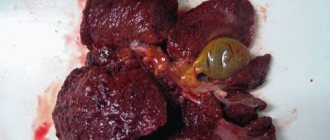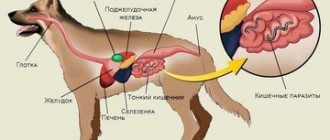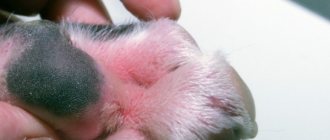Considering the widespread prevalence of infections in nature, it is not surprising that they occur quite frequently in our pets. A dog can catch the disease anywhere, since many diseases of this type are transmitted by airborne droplets. It is important to know how at least some infectious diseases manifest themselves in dogs , since in this case you will most likely take your pet to the veterinarian on time.
Canine coronavirus infection
This disease is one of the leading causes of profuse diarrhea in puppies. Coronavirus infections are characterized by a high mortality rate in young animals. Adult dogs get sick extremely rarely. This is explained by the fact that the blood of these animals already contains antibodies to this pathogen. They receive them while suffering from mild forms of infection. How widespread is the pathogen in the external environment? The prevalence is very wide, since the virus is released into the external environment in the amount of millions of units every day. The pathogen is covered with a thick fat-like membrane that is resistant to temperature and light. To ensure that the virus is destroyed, it is necessary to use alkaline disinfectants.
Symptoms
The main symptom is severe, debilitating diarrhea in young pets. Unlike parvovirus infections, vomiting with coronavirus is rare. However, without laboratory tests it is impossible to distinguish these two ailments . In addition, experienced veterinarians today are inclined to believe that these pathogens can cause a combined infection. But the coronavirus is not only distinguished by its “intestinal” manifestations. Not less often, it causes eye diseases, manifested in the form of severe conjunctivitis. The conjunctival cavity is severely inflamed and swollen, and liquid or thick, purulent exudate constantly oozes from the corners of the eyes.
In these cases, puppy mortality rates can reach 90%. Animals less than 12 weeks old are considered to be at particular risk. It is among this group that mortality rates are highest. If three days or more have passed since the onset of cynic signs, and your pet is alive, then he will most likely be able to recover. So once again we remind you how important vaccinations (on time) are for all pets. Don't waste your time and money, visit your veterinarian regularly , and don't neglect vaccinations. It may well save your pet's life!
Treatment
There is no specific therapy; symptomatic therapy is prescribed for the disease. The most important thing is to prevent the development of dehydration. In mild cases, the animal simply needs to be provided with an unlimited volume of clean drinking water, but more often it is necessary to administer intravenously special compounds for dehydration and relief of intoxication.
How is the disease transmitted from dog to person?
Contagious diseases of dogs can be transmitted in various ways, but the most common way is through fur. Play with the dog, pet it, and then you can pick up parasites that are transmitted through the fur. In particular, these are scabies, ringworm, and demodicosis. It is wool that becomes the main cause of human infection. Remember how many times a day you pet your dog, and how often do your children do this?
Similar article - Miconazole tablets for thrush
Another source of human infection from a dog is saliva. Of course - doctors say that dog saliva contains an active substance that helps blood clot. But this is if the dog is healthy. Dog saliva can contain very dangerous infectious agents - tuberculosis, helminthiasis, toxoplasmosis, leptospirosis, giardiasis in dogs, rabies. Owners simply squeal with happiness when their pet licks its face. The dog may also (as a sign of submission) lick his hands. Also, saliva remains on the toys she plays with.
Viruses and parasites can also be transmitted through food. This is a less common source of infection, but the fact remains. Of course, a normal person would not eat the food that a dog eats. But many owners have small children who do not yet understand that they cannot eat from a dog’s bowl. But in medical practice, there are cases where dogs stole food from the table and at the same time contaminated other food products. Therefore, it is strictly forbidden to eat foods that the dog has touched.
Stealing food is a favorite pastime for pets. And, in order to do their “dirty deed”, they can jump on the table, climb into the completely uncovered refrigerator. And there have even been cases when dogs opened the refrigerator themselves. Doctors recommend keeping food away from your pets, and if your pet gets creative, it's best to keep the kitchen locked.
Blood, just like food, is not such a common source of infection. But your dog's blood can get on your hands, face, and open wounds. Sometimes dogs that are sorting things out with each other can get into a fight and the owners then separate the pets.
Blood from dog fights can get on your skin. Also, during fights, one of the individuals may accidentally bite a person. But that is not all. Glass on the road, splinters and open wounds on a dog can become a source of infection. Through the same wound, an infection can enter the bloodstream, which, if handled carelessly, can infect a person.
Ehrlichiosis in dogs
A common infectious disease of all canines, carriers of which are found throughout the world. However, veterinary infectious disease specialists are inclined to believe that the disease became especially widespread after the events in Vietnam, when service dogs spread the infection throughout the world. What pathogen causes this disease? Common strains found in dogs include E. chaffeensis, E. ewingii, and possibly E. ruminantium. However, this is not the entire list. There are a lot of Ehrlichia strains, and some of them are universal and can affect several species of animals at once. There are also variants that can be transmitted to humans.
Note that some microorganisms, which researchers until recently considered representatives of Ehrlichia, now belong to Anaplasma. Ehrlichia themselves are rickettsiae.
Transmission routes
The pathogen is transmitted from animal to animal through the bites of blood-sucking ixodid ticks. In the body of the latter, a microscopic parasite can live for five months or even six months, so a tick that has hibernated in winter can infect your dog in early spring. Considering that due to climatic changes, the distribution area of ticks is constantly expanding, the prevalence of ehrlichiosis is also increasing.
Symptoms
What are the symptoms? The disease has three clinical phases. Signs of acute infection can be seen two to three weeks after the tick bite. Its total duration rarely exceeds four weeks. At this time, ehrlichia damage leukocytes, penetrate them, and begin to intensively feed on the “stuffing” of protective cells. Parasites quickly end up in the lymph nodes, spleen, liver and bone marrow.
The danger of ehrlichiosis is also that platelets are damaged and destroyed during the disease. These are the cells responsible for the blood clotting mechanism. As a result of infection, the lymph nodes, liver, and spleen often become enlarged. Anemia, fever, depression, lethargy, loss of appetite, shortness of breath, severe joint pain - all these signs are also characteristic of ehrlichiosis to varying degrees. It is reported that in approximately 30% of animals the body eventually copes with the infection, otherwise it becomes subclinical.
In this phase, the pet seems absolutely healthy; only a blood test can reveal mild anemia. All parasites are concentrated in the spleen and do not enter the general bloodstream, and therefore diagnosis is extremely complicated or even impossible. The duration of this phase can reach several years. This either ends with the animal’s immune system getting rid of the infectious agent, or the disease becoming chronic (the most undesirable outcome).
The chronic phase can be moderate or severe. Weight loss, anemia, neurological seizures, spontaneous bleeding, inflammation of the eyes, swelling of the hind legs and dewlap area, and intermittent fever are all seen from time to time in a dog with chronic ehrlichiosis.
Blood tests reveal an alarming pattern of decreased numbers of all major cell types. Only in some cases is a pathological increase in the number of lymphocytes detected. It is for this reason that ehrlichiosis is sometimes confused with some forms of leukemia.
Aviary cough
This disease is also known as infectious tracheobronchitis - an acute contagious disease of dogs, which is caused by a complex of bacteria and viruses. They can have a negative impact not only in aggregate, but also separately from each other. Among them are parainfluenza virus, adenovirus type 2, reovirus, canine herpes, streptococci, staphylococci, mycoplasmas, and the bacterium Bordetella bronchiseptica.
An infected animal spreads the disease mainly through saliva, nasal secretions, and tear fluid. Less commonly, infection occurs through urine and feces. Therefore, the main route of infection is airborne; contact and household transmission is less common, but it is still not excluded. Keeping several animals in one enclosure and poor hygienic conditions increase the risk of infection. Also in the danger zone are visitors to dog shows, or areas with mass walking of pets, although the risks in this case are reduced, they remain.
The first symptoms of infection may appear within 1-3 days, up to a maximum of 10 days. A healthy animal copes with the infection on its own by 7-10 days thanks to a strong immune system. But this is the case if kennel cough is caused by a virus, since bacteria and mycoplasmas can be present in the body longer, and accordingly, clinical symptoms will appear later. As a result, the disease can become chronic.
Symptoms of aviary cough
Clinical signs of kennel cough include:
- Dry paroxysmal cough. Appears a few days after the onset of the disease. Cough is the main symptom of the disease. It may intensify when exposed to an irritant, and over time, foamy white sputum appears, which may resemble scanty vomit in appearance.
- Discharge from the nose, eyes.
- Increased body temperature.
- Depressed mood, apathy.
Respiratory symptoms increase over time, which indicates the addition of a bacterial infection, and as a result, the development of pneumonia.
The duration of the disease and the severity of its course directly depend on the animal’s immune status and the number of infections that provoked enclosure cough. Chronic diseases of the bronchopulmonary and other organs and systems, vaccination and other preventive measures also affect the severity and the possibility of getting sick, although they are not a 100% guarantee of safety. However, it is precautionary measures that significantly reduce the risks and duration of the disease when diagnosed. An adult healthy dog can get sick from this type of cough within 1-2 weeks without any consequences. But puppies are more vulnerable, since their immunity is weaker. Adults with a history of chronic diseases are at risk of complications such as pulmonary edema.
Competent, qualified assistance from a veterinarian is the main aspect in the treatment of kennel cough in dogs. You should not delay your visit to the veterinary clinic, and at the first signs of illness it is necessary to show your pet to specialists.
Infectious enteritis
The term "enteritis" is used in human and veterinary medicine to refer to inflammation of the small intestine. There can be many causes of pathology. Such inflammation can be caused by parvovirus, coronavirus, rotavirus, salmonellosis, parasites, etc. In this case, we are more interested in viral infections, since they have the worst effect on the condition of the animal’s digestive tract.
Symptoms
The most common and characteristic sign of enteritis is severe, profuse diarrhea. As a rule, intermittent fever is also diagnosed. However, with viral enteritis this symptom does not occur very often. Feces are very unpleasant and even smell disgusting.
The “aroma” is explained by the fact that due to the disease, the intestinal mucosa literally begins to peel off and rot, resulting in the formation of a thick paste. Because of this, the consistency of stool with viral enteritis may resemble pea soup. If the disease has progressed far enough to cause damage to the intestinal wall, copious amounts of blood may appear in the feces.
True, more often with enteritis, melena appears - a viscous black mass (digested blood) . Red impurities occur only if the source of bleeding is somewhere near the large intestine. Regardless of the specific type of pathogen, it is impossible to accurately determine its type without complex diagnostic tests, carried out only in very well-equipped veterinary clinics.
Forecast
Almost all cases of intestinal infections should be considered “in absentia” quite dangerous, since they lead to severe dehydration and intoxication, which negatively affects the body of any dog, and young animals may well die from this. As a rule, pets over the age of six months are relatively safe, while younger dogs suffer from the disease much more severely. However, the same can be said about “elderly” dogs, whose immune system can no longer effectively resist infectious agents. In addition, outbreaks of infection are very common in nurseries and other places where animals are kept crowded.
Treatment
Oddly enough, in moderate cases of enteritis there may be no treatment as such. If your pet develops only mild diarrhea, it (usually) goes away within two days (this does not apply to puppies, old or weakened animals). In other cases, symptomatic therapy is prescribed, including the mandatory prescription of adsorbent drugs.
Important! Some adsorbents contain bismuth salicylate. In principle, you can give it to dogs, but it is advisable to do this under the supervision of a veterinarian. But! If the dog is receiving anti-inflammatory corticosteroids at this time, the administration of medications containing salicylates is strictly prohibited. The combination of these drugs can cause massive internal bleeding.
Types of infectious diseases in dogs
Diseases caused by one type of bacteria are classified as mono-infections, while diseases caused by several groups of viruses are classified as mixed. Secondary infections (superinfections, secondary infections) occur against the background of existing diseases and pathologies.
If microorganisms activate and aggravate the course of the disease, they are classified as activators or synergents. For example, influenza viruses, group B streptococci. Microorganisms that suppress the pathogenic effect are prescribed as antagonists. For example, E. coli inhibits the activity of salmonella, shigella, streptococcus and staphylococcus.
The pathogenicity of macroorganisms is determined by the totality of pathological processes caused in the body. Virulence determines the degree of pathogenicity of a particular type of pathogenic flora. This term explains the ability of pathogenic agents, microorganisms to penetrate tissues, cellular structures, and form substances that have a detrimental effect on the host body.
Secondary infections (superinfections) develop against the background of existing diseases.
Infectious diseases pose a particular danger to young dogs, puppies, and those with an unformed immune system. Weakened, emaciated dogs and animals kept in groups under unfavorable conditions are at risk.
Most diseases caused by pathogenic bacteria, if not diagnosed in a timely manner and the correct treatment not prescribed in a timely manner, can cause death. Therefore, owners throughout the dog’s life must closely monitor the condition and behavior of their pet. In case of any changes, if even the most minor symptoms appear, you should take your beloved pet to a veterinary clinic as soon as possible. The sooner treatment is prescribed, the greater the chances of a speedy recovery and a favorable prognosis.
After suffering from diseases, an animal’s body develops immunity to a certain type of virus and bacteria. It should be taken into account that the dog remains a virus carrier for some period of time. For seven to twelve days, if there are other pets in the house, as well as to prevent infection of other animals, the dog is kept in quarantine, carefully observing its behavior.
Staphylococcal inflammation of the skin
In addition to those described above, skin infections also occur in dogs. Staphylococci are especially dangerous, as they cause purulent inflammation of the skin. How do you know if your pet is suffering from staphylococcal pathology? Clinical signs depend on the severity of the case. As a rule, it all starts after minor injuries (scratches and abrasions).
If they are contaminated with a pathogen, redness will appear, and when you try to palpate, a noticeably increased local temperature is felt. A painful reaction and severe itching occurs. The dog constantly scratches the affected areas of the skin, as a result of which the pathological process only worsens and the release of purulent exudate begins.
How dangerous are staph infections for your dog? It all depends on the specific case. If the inflammatory focus continues to grow with the appearance of new lesions, everything can end very badly (severe intoxication and sepsis will develop).
Treatment
Bacterial infections are often secondary to other diseases, so the veterinarian will check the dog for the presence of hormonal, parasitic and other pathologies. The diagnosis is confirmed by growing cultures of the pathogen on nutrient media (a sample of the affected tissue is taken for this purpose). As a rule, staphylococcal infections are treated using loading doses of broad-spectrum antibiotics for this purpose.
Diagnosis of bacterial infections
To carry out diagnostics, based on the results of which the veterinarian can prescribe appropriate effective treatment, a series of laboratory, biochemical, serological studies, and instrumental methods are used. Conduct a visual examination of dogs with bacterial infections and palpation. Ultrasound, radiography, take into account clinical symptoms and anamnesis data.
Considering the similarity of clinical symptoms, differential diagnostics (PCR, ELISA), skin biopsy, and sensitivity testing (allergy tests) are performed. Laboratory tests of pathological material are also carried out using the culture method.
Leptospirosis in dogs
A widespread infectious disease, especially characteristic of swampy areas. The full scientific name of the pathogen is Leptospira interrogans sensu lato. There are many different serotypes, and eight of them are dangerous for dogs. Let's look at these types of pathogens in the table below.
Symptoms
There are several possible routes of transmission:
- Along with contaminated urine.
- Sexually transmitted and transplacental transmission.
- Bite wounds.
- Eating infected intermediate hosts.
The more crowded the animals are, the higher the likelihood of infection. The natural habitat of Leptospira is stagnant and slowly flowing water. Unlike many other microorganisms, Leptospires tolerate freezing well. Most cases of the disease are diagnosed in summer and autumn.
Diseases that can be contracted from a dog
There are two types of threats to humans that can be contracted from a dog. Any disease can affect either one type of carrier or several types. For example, fleas (Ctenocephalides canis) do not bite humans, just as human fleas (Pulex irritans) do not bite animals.
But there are parasites that are harmful to both humans and pets. Also, some helminths can travel on the same fleas. Therefore, timely removal of parasites from the dog’s body can save not only his life, but also your life. So what diseases can you get from a dog?
Tuberculosis bacillus (or Koch bacillus). A very common disease in our time, which many experience very hard, and the disease tends to be chronic. The disease itself manifests itself in the lungs and lymph nodes. This is an inflammatory process that is accompanied by swelling and a dry cough. The infection is transmitted through saliva and animal bites.
Helminthiasis (Helminths). Parasitic organisms that enter the body in the form of a cyst. The protective shell of helminths can withstand very low temperatures. And when the cyst gets into a suitable environment, it hatches into an adult, which attaches to the wall of the stomach and begins to reproduce.
Rabies . A viral disease that affects the nervous system. The nature of the disease is that in the brains of animals affected by the virus there are special inclusions of “Babes bodies”. They range from 1 to 27 microns. Rabies is transmitted to humans through a bite.
Toxoplasmosis . When asked whether you can get toxoplasmosis from a dog, you can safely answer yes. Most often, these parasites enter an animal through unprocessed food, and then through saliva and bites to humans. In this case, an infected person experiences headaches, high fever, and high blood pressure, which soon leads to blindness, cardiac arrest and damage to the nervous system. But a person may not even be aware of the infection for a long time, and toxoplasmosis develops in a latent form.
Leptospirosis . Caused by Leptospira. This is an infectious disease that is accompanied by severe headaches, muscle pain and joint problems. The disease gradually progresses into a severe form with an elevated temperature, like the flu. All this may be accompanied by nausea and vomiting. You can become infected through saliva and blood. Although most often due to insufficient heat treatment of the affected products.
Scabies . A skin disease caused by the scabies mite parasite. The female parasite crawls under the skin and lays eggs. At the site where the eggs are laid, unbearable itching begins, which is accompanied by small redness in the form of pimples. Carriers of scabies mites are animals that spread the parasite to areas of the skin on their fur.
Cucumber tapeworm . A parasite that enters the human body through unprocessed food or saliva. Adult tapeworms rarely inhabit the human body. Most often it develops from a cyst that is accidentally ingested when it comes into contact with an animal. In this case, tapeworm parasitism is accompanied by headaches and dizziness. The skin becomes pale and appetite decreases. At the same time, appetite decreases, but even if the patient forces himself to eat, he does not gain weight and there is itching in the anus.
Tick-borne borreliosis . A virus that is transmitted through the bite of an Ixodid tick. The disease penetrates through the blood and affects all organs connected by blood vessels: heart, nervous system, muscles, etc. As a result, antibodies begin to work against the body, and not for good. When the pathogen dies, it releases a huge amount of poison into the blood, causing a deterioration in the condition.
Parainfluenza in dogs
A fairly common infection, especially dangerous for young animals. It is interesting because several types of pathogenic microorganisms can cause a disease with the same name. In particular, “parainfluenza” may actually refer to illnesses caused by Bordetella or Mycoplasma. It is assumed that pathologies caused by adenoviruses, retroviruses and similar pathogens lead to the same clinical signs. Researchers now believe that canine parainfluenza is caused in most cases by a combination of pathogens.
If the disease is caused only by viruses, the symptoms are very vague and the disease, as a rule, goes away on its own in about six days (the maximum that threatens the dog is mild conjunctivitis and minor diarrhea). Bordetella bronchiseptica is the most common cause of parainfluenza, and it is also the most dangerous. The first clinical signs appear 10-12 days after infection.
It is believed that even after recovery, the animal can release the pathogen into the external environment for at least six months. The symptoms are quite varied: the pet develops rhinitis, conjunctivitis, cough (in severe cases, bronchitis and even pneumonia are possible), oral ulcers, etc. There is no specific treatment ; symptomatic and replacement therapy is prescribed.
INFECTIOUS TRACHEOBRONCHITIS
Infectious tracheobronchitis, or more precisely, infectious laryngotracheobronchitis (synonyms - kennel cough, kennel cough or kennel cough) is an extremely contagious disease of a polyetiological nature, caused by Bordetella bronchisрtica, as well as various viruses (adenoviruses, canine herpesvirus, parainfluenza virus, reoviruses, etc.) and mycoplasmas. Most often, the disease is observed when dogs are kept in crowded conditions in kennels and shelters. The incubation period is usually 3-10 days after infection.
Symptoms: acute attacks of dry cough, sometimes paroxysmal, especially after physical activity. In severe cases - vomiting, sometimes serous and mucous discharge from the nose, rarely - fever and anorexia.
As a rule, clinical symptoms disappear after 1-3 weeks and the animals recover. A possible complication is bronchopneumonia.
Prevention: there is no vaccine against all possible pathogens, but vaccination against adenoviruses with vaccines such as Nobivac DHP and others has a good effect.
Aujeszky's disease
It was first described by a Hungarian veterinarian, from whose name the pathology got its name. The second name is “false” or “pseudo-rabies”. As you can easily guess from the name, the pathology is accompanied by phenomena similar to the clinical signs of rabies. Therefore, one should treat Aujeszki’s alleged with extreme caution: it is possible that this is not “pseudo”, but real rabies. The causative agent is a herpes virus. The disease can affect not only dogs, but also cats, minks, arctic foxes, cattle and horses. Fortunately, humans are not susceptible to infection.
The virus is transmitted through eating contaminated food. However, there is an opinion about possible contact infection, including through bites of relatives or other animals. The disease is very contagious, for dogs it has an almost 100% mortality rate , cases of recovery are extremely rare. The first clinical signs appear 10-12 days after the pathogen enters the body.
A cough, severe conjunctivitis and rhinitis develop, and a lot of exudate is released from the nose and eyes. But these are minor things. Soon the animal develops phantom itching. It is so strong that many cases have been described when an unfortunate dog gnawed his own paws to the bone, trying to cope with “scabies”. Possible depression, periodically replaced by uncontrollable excitement. The animal runs in circles without reacting to external stimuli, and sometimes just stands with its head against the wall.
Remember that with Aujeszky's disease, unlike rabies, the dog retains its appetite, eats only edible foods (and not sticks with bags), and is not afraid of water. In addition, it is not typical for Aujeszka to produce large volumes of saliva!
Unfortunately, there is no cure .
There is evidence that in some cases hyperimmune serum made from the blood of horses helps.
Major infectious diseases of dogs
The author of the article is veterinarian Podymova A.A.
Infectious diseases in dogs are common; they can threaten the life of your Pet, therefore they require mandatory diagnosis and comprehensive treatment. Let's look at the main ones.
Carnivore plague
This is a highly contagious disease caused by a paramyxovirus.
The source of infection is sick and recovered animals, which release the virus into the environment through discharge from the nose, eyes, urine, feces, and saliva. Infection occurs through direct contact with sick animals or through infected feed, excretions, or care items.
Clinical manifestation begins with increased body temperature, lethargy, lack of appetite, and discharge from the eyes and nose.
There are several forms of the disease:
Pulmonary: i.e. affecting the respiratory system. Rhinitis, bronchitis, and pneumonia develop.
Intestinal: accompanied by refusal to feed, vomiting, diarrhea.
Nervous: there is excitement, barking, loss of coordination, paralysis, convulsions, even death.
Skin: small red spots appear on the thighs, abdominal wall, ears, and blisters with contents form.
Mixed: accompanied by symptoms of all forms of plague.
In acute and severe forms of the disease, the prognosis is unfavorable (up to 90% mortality).
For diagnosis, it is necessary to examine blood and smears of the nasal mucosa using PCR and ELISA methods.
The treatment is comprehensive, aimed at destroying the pathogen; the animal is given symptomatic treatment (antibiotic therapy, immunotherapy, infusion therapy to relieve the state of intoxication and dehydration).
Prevention: annual timely vaccination.
Damage to the eyes and nasal planum with carnivorous plague.
Parvovirus enteritis
A highly contagious disease of dogs caused by parvovirus. Mortality is high, up to 90%.
The source of infection is patients and virus-carrying animals that excrete the virus in their feces. Infection occurs through direct contact with a sick animal, as well as through infected food and care items.
Animals experience weakness, refusal to feed, uncontrollable vomiting, diarrhea (fetid watery), an increase and then a decrease in body temperature. In some cases, the heart muscle is affected. Animals in such cases die from myocardial necrosis and pulmonary edema.
For diagnosis, it is necessary to conduct stool examinations, take a smear from the rectal mucosa using the PCR method, and blood using the ELISA method.
Treatment should be comprehensive (etiotropic, pathogenetic, symptomatic), aimed both at combating the virus itself and at restoring the body and relieving symptoms of the disease.
Prevention: timely vaccination.
Bloody, watery diarrhea in a puppy due to parvovirus enteritis.
Coronavirus enteritis
An infectious disease of dogs caused by coronavirus, which, like parvovirus, affects the digestive system.
The source of infection is sick animals that excrete the virus in their feces. Infection occurs through direct contact with a sick animal, through infected care items or food.
Pronounced symptoms are more often observed in puppies: anorexia, vomiting, prolonged diarrhea, and high mortality is observed. In adult animals, it can occur latently, manifested by refusal of food, depression, and vomiting and diarrhea may also occur.
For diagnosis, it is necessary to study stool using the PCR method and blood using the ELISA method.
Treatment is complex (antibiotic therapy, immunotherapy, infusion therapy to relieve intoxication and dehydration).
Infectious hepatitis
A disease caused by an adenovirus and characterized by liver damage.
The source of infection is sick dogs that excrete the virus in urine, feces, and saliva for a long time. Infection occurs through direct contact, through infected food and care items.
Currently, a chronic course with low mortality rates is more common.
Clinical signs: lethargy, refusal to feed, vomiting (often with bile), diarrhea, increased body temperature, there may be discharge from the eyes, nose, keratitis.
With severe symptoms of infectious hepatitis, mortality is high.
For diagnosis, it is necessary to study blood, rectal lavage, and stool using the PCR method.
Treatment is complex, including etiotropic and symptomatic.
Prevention: timely vaccination.
Infectious tracheobronchitis (“aviary/kennel cough”)
A disease caused primarily by viruses (adenovirus, herpes virus, plague virus, etc.) and secondarily by bacteria (Pseudomonas, Klebsiella, Streptococcus, etc.). Often occurs after visiting exhibitions, nurseries, i.e. places with large numbers of animals.
Infection occurs by airborne droplets.
In the uncomplicated form, a cough is observed and sputum may be produced. The severe form is often accompanied by fever, nasal discharge, and pneumonia develops.
For diagnosis, swabs from the nasal cavity and trachea are examined using PCR.
With adequate treatment, the prognosis is favorable.
Prevention: keeping new animals under quarantine conditions.
Herpes virus infection
A viral disease characterized by severe course and high mortality in puppies. Adult animals also get sick.
Infection occurs by airborne droplets, through sexual contact, in utero (from mother to fetus).
Clinical signs in newborn puppies: lack of appetite, shortness of breath, abdominal pain, diarrhea, vomiting. They die within 1-2 days. Severe disease is rare in puppies older than 2 weeks. In adult animals, it often occurs latently or in a mild form. Respiratory symptoms are observed - cough, shortness of breath, discharge from the eyes, nose, lesions of the genital organs - inflammation, pathological discharge, formation of bubbles with liquid. Pregnant women experience miscarriages and stillbirths.
For diagnosis, it is necessary to take a smear from the mucous membranes of the eyes, nose, vaginal wash for examination using the PCR method, and blood using the ELISA method.
The treatment is complex. Antibiotic therapy, immunomodulators, cleansing the eyes and nasal cavity of secretions in the presence of respiratory symptoms.
Animals that have recovered from the disease remain carriers of the herpes virus for life.
Taking a smear from the conjunctiva to confirm herpes virus infection.
Chlamydia
An infectious disease characteristic of many animal species, including humans.
Infection occurs in various ways: through direct contact with a sick animal, nutritionally (by eating raw meat contaminated with chlamydia), aerogenously (including by sniffing infected birds, rodents, their corpses, droppings), during mating, from mother to offspring.
Chlamydia can occur without obvious clinical manifestations, while the animal will be a source of infection for others, including humans.
Depending on the localization of chlamydia in the body, the general condition and resistance of the body, the following clinical signs are distinguished: weakness, increased body temperature, discharge from the eyes, nose, eye damage (conjunctivitis), respiratory system (shortness of breath, rhinitis, bronchitis), digestive system ( lack of appetite, diarrhea, vomiting), genitourinary system (cystitis, urethritis, profuse discharge from the genitals, inflammation, swelling), otitis, arthritis, arrhythmias, leads to abortion, infertility. In severe cases, the puppies die.
For diagnosis, swabs are taken from the conjunctiva, nose, and genital tract for examination using the PCR method.
Treatment is complex, including long-term antibiotic therapy and symptomatic therapy.
Mycoplasmosis
A group of infectious diseases caused by an opportunistic microorganism of the Mollicutes class. Mycoplasmas live in soil, can be part of the normal flora of animals, and can also be pathogens of infection in plants, animals and humans.
In dogs, infection occurs through contact, respiratory, nutritional, and sexual routes.
Often with mycoplasmosis there is a secondary bacterial infection. Clinical signs will depend on the localization of the pathogen and the body’s resistance. May be asymptomatic. Often there is conjunctivitis, profuse discharge from the eyes, as well as damage to the respiratory system - rhinitis, coughing, sneezing; genitourinary – cystitis, urethritis, balanoposthitis, vaginitis, abortion. Possible arthritis, lameness, dermatitis, abscesses, weakness, fever, diarrhea, vomiting.
For diagnosis, smears are taken from the conjunctiva, swabs from the genital organs, and from the bronchi for research using the PCR method.
Treatment: antibiotic therapy, immunostimulants.
Stable immunity is not formed after illness, and recurrent illness is possible in the future.
Leptospirosis
A disease of wild and domestic animals, including humans, caused by Leptospira.
The source of infection is sick animals and carriers of Leptospira, which release them into the external environment mainly through urine. Infection occurs through contact, through contaminated water, including water bodies, feed, care items, soil, and by eating rodents carrying Leptospira.
Leptospirosis is recorded more often in the warm season.
There are hemorrhagic and icteric forms.
Hemorrhagic: adult dogs are more often affected. Characterized by lethargy, refusal to feed, increased body temperature, redness of the mucous membranes, vomiting and diarrhea with blood, acute renal failure, and there may be hemorrhages in the internal organs.
Jaundice: more common in puppies. Characterized by lethargy, refusal to feed, yellow discoloration of the mucous membranes and skin, vomiting, diarrhea, hemorrhages in the mucous membranes, skin, and acute renal failure.
In severe cases, mortality is high. Upon recovery, animals remain leptospiron carriers for a long time.
For diagnosis, the blood and urine of a sick animal are examined using ELISA and PCR methods.
Treatment requires comprehensive treatment, aimed at eliminating Leptospira in the body, relieving symptoms and restoring normal functioning of organs.
Prevention: timely vaccination, control of Leptospira vectors.
Yellowness of the oral mucosa due to leptospirosis in a dog.
Rabies
A lethal disease caused by rhabdovirus, which is also dangerous for humans.
Infection occurs through bite wounds and damaged skin, where the saliva of a sick animal gets in. The incubation period averages 14-60 days.
There are several forms of the disease:
- Aggressive (“violent rabies”) , there are 3 periods:
1) prodromal: up to 3 days. Animals are apathetic or overly friendly, affectionate, restless, timid.
2) excitement: 3-4 days. The animals are aggressive, gnawing earth, iron and other objects. Periods of violence are replaced by depression, paralysis of individual muscles, hoarse barking, loss of coordination, and drooling occur.
3) paralytic: 1-4 days. Paralysis of the lower jaw, hind limbs, bladder, death.
- Quiet fury
Excitement is mild, severe salivation, difficulty swallowing, paralysis of the lower jaw and limbs.
- Atypical
Without the stage of excitement, it can occur with manifestations of gastroenteritis: exhaustion, vomiting, liquid feces, and there may be an abortive course.
Treatment is prohibited.
Prevention: annual vaccination.
Pathological aggression of an animal with rabies
When the first symptoms of an infectious disease are detected, it is imperative to show the animal to a veterinarian to make an accurate diagnosis and provide the necessary treatment to your Pet.
To reduce the likelihood of a pet getting sick, it is necessary to comply with zoohygienic and veterinary requirements for keeping and feeding, carry out annual vaccinations, and avoid contact with stray animals.
BE HEALTHY!!!
Infectious hepatitis
An extremely dangerous infectious disease caused by type 1 (CAV-1) adenovirus. Characterized by serious destructive liver lesions. The pathogen is distributed throughout the world; it is excreted in abundance from the body of sick animals in feces, urine and saliva. Recovered dogs can be carriers of infection for nine months. The source of transmission is contaminated food, water, care items, etc.
Initially, the virus affects the tonsils and larynx, which causes a sore throat, cough, and sometimes pneumonia. The virus multiplies quickly in the blood, which is why it quickly and in large numbers enters the liver and kidneys. The cornea of the eyes becomes very cloudy and “foggy.” This happens because the virus multiplies in the cells of this tissue, mercilessly destroying them. As soon as the liver is affected to a “sufficient” extent, the dog develops jaundice, diarrhea, and severe vomiting (due to serious intoxication).
As a rule, young animals under the age of one year are affected, but the disease can affect all dogs, regardless of their age, breed and physiological condition. The pathology often occurs in a lightning-fast form, when death occurs within a couple of hours after the appearance of the first clinical signs. There is no specific treatment; symptomatic therapy is used. Only timely vaccination can save you from infection.
Parvovirus enteritis
Infection occurs through water, food, and any contact with an infected animal. The incubation period is from 4-10 days. One month old puppies have 2-3 days. The causative agent is parvovirus, which causes inflammation and necrosis of the intestinal mucosa. Mortality in nursery conditions is 50-90%. Progression of the disease. The disease begins violently and suddenly, the main signs are foamy vomiting, foul-smelling diarrhea with blood, pale mucous membranes of the mouth, low temperature. The dog does not eat, drinks poorly, is apathetic, and is not very active. Very young puppies die immediately from heart failure. Death occurs on days 1-3 from dehydration, painful shock during spasms, poisoning by metabolic products, or from heart failure. If the dog survives this period, then it has a chance to recover already on the 5th day.
Treatment of the disease. To help the dog survive this disease, they first stop feeding it completely. Absolutely means not feeding at all. The dog is only given water by adding a spoonful of honey to the water. In addition, an enema is given with chamomile infusion until clean water flows out of the dog. You need to give your body as much water as possible. Rinse the body thoroughly. To combat toxicosis and dehydration, a saline solution with glucose is given intravenously. For pain relief, they give no-shpa (injections). For the heart, camphor or sulfacamphocaine is given. For rehabilitation therapy, vetom, B vitamins, and probiotics are given. But the treatment regimen and medications must be prescribed by a veterinarian, so at the first symptoms of the disease, take the animal to the doctor without delay.
Feeding begins on day 2-3 with fermented milk products, they serve as prevention. A dog that has recovered from the disease develops immunity for the rest of its life. Next, you should definitely get vaccinated.
Carnivore plague
Contrary to popular belief, distemper in dogs (and cats too) has nothing to do with the human disease. If only because in the first case the disease is caused by a virus, and in the other by a bacterium. The causative agent is an RNA virus that is unstable in the external environment. The disease is transmitted (usually) through nutrition, that is, by eating contaminated food or drinking dirty water. It happens that a pet becomes infected with “distemper” by eating an infected mouse, rat, or other small animal. There is also evidence that insects can act as carriers.
PLAGUE
Plague (canine distemper, canine distemper, Carré disease) is an acute viral disease characterized by damage to the respiratory, digestive, skin, and nervous system. Dogs of all ages are affected, but more often from 2 months of age. up to 3 years. The causative agent is the canine distemper virus, which belongs to the family of paramyxoviruses (genus morbillivirus) and is transmitted through the digestive tract and respiratory tract. The virus is extremely unstable in the external environment. Mutts, terriers and boxers are relatively resistant to the disease. Dogs of cultivated and decorative breeds are the least resistant. The mortality rate among dogs is about 50%. As a rule, dogs that have recovered from the disease develop lifelong immunity, although the resistance of recovered animals to re-infection is not absolute. Puppies from immune mothers, as well as suckling ones, are immune to plague for 2-3 months.
Infection occurs by airborne droplets. The incubation period lasts from 2 days to 2-3 weeks, and the disease itself can be acute, hyperacute and even fulminant in nature, in which dogs can die suddenly, without showing clinical signs. In a hyperacute course, the disease lasts 2-3 days, the temperature rises sharply, the animal refuses food, a coma occurs and the dog dies. In acute cases, the disease lasts 2-4 weeks. There are catarrhal (pulmonary), intestinal and nervous forms of the disease. Plague often ends in the death of the animal. The course of the underlying disease can often be complicated by secondary (secondary) bacterial infections.
Symptoms: in “classical” cases, the temperature rises to 40-41°C within a week after infection, and clinical symptoms of a generalized disease develop after a few weeks. They include: lethargy - the dog sleeps a lot, tends to hide in dark corners, refuses food; the eyes are red, purulent exudate is released from them; the tip of the nose is absolutely dry, rough, characterized by mucopurulent discharge; A small red rash may appear on hairless areas of the abdomen; Possible diarrhea and vomiting; breathing is difficult, the dog is coughing, wheezing in the throat; You may notice streaks or blood clots in the stool. In the nervous form (can be acute or chronic) - twitching of the limbs, trembling of the lower jaw, whining, complete paralysis is possible (usually with a long course of the disease) and epileptic seizures. In dogs recovered from distemper, persistent infection in the central nervous system can lead to “senior canine encephalitis” after several years.
The “classical” form of the disease is quite rare, and more often the infection affects only one system of the body: the respiratory, digestive or central nervous system.
Prevention: You can prevent plague by strictly following the vaccination schedule prescribed and carried out by your supervising doctor. In addition, to prevent viral infections, animals are administered subcutaneously with 3.0 ml of Vitacan (a complex of gamma and beta globulin fractions of the blood serum of hyperimmunized dogs against canine distemper, parvovirus enteritis, etc.) once or twice with an interval of 1 day. After the period of formation of passive immunity has expired (2 weeks), vaccination is carried out to create active immunity.
Rabies
A terrible disease, dangerous to almost all species of mammals and humans. Mortality rate is 99.99%. Since the first descriptions of the disease appeared, no more than a dozen cases of recovery have been recorded. The causative agent is an RNA virus. He's quite unusual. Unlike other viruses, it can survive for quite a long time (up to a couple of months) in the external environment, and in the rotting brain of a dead animal - up to two (or even three) years. Transmitted through bites. There are no other ways of infection.
After a bite, the pathogen enters the nervous tissue, from where it begins to gradually rise, reaching the brain. The closer the bite area is to the head, the faster clinical signs of infection will develop. As a rule, this happens within three to five days. If a pet has already developed clinical manifestations of the disease, it is no longer possible to save it.
How does rabies manifest itself? There are two forms of infection: silent and classic. In the first case, the animal becomes unusually quiet, affectionate, drooling does not flow from its mouth, but the pet is terrified of water and completely loses the ability to swallow. When in violent form, the dog becomes extremely aggressive, silently and without barking (the larynx is paralyzed) and rushes at people and other animals.
From time to time, seizures reminiscent of epileptic occur, and saliva constantly runs from the dog’s mouth. If you observe any of the above in your dog, call the vet immediately! Try to isolate the dog in a separate room (without fanaticism). Remember that rabies is incurable! It is impossible to cure him, and therefore the sick dog is euthanized, and the corpse is destroyed by burning.
How to protect your pet - prevention of enteritis in dogs
Since the causative agent of parvovirus infection in dogs is stable in the external environment, and the disease is characterized by a high rate of development of life-threatening symptoms, it is extremely important for the owner to know the basic points that will help prevent infectious enteritis in his dog.
Vaccination of puppies
This method is considered the most effective in preventing the disease. The domestic industry produces several versions of vaccines, which must be used in accordance with their instructions. Of the budget, but no less effective vaccines, the most commonly used are:
- Culture-inactivated vaccine against parvovirus enteritis in dogs.
- Multikan-4, which includes the prevention of not only parvovirus infection in dogs, but also distemper, adenovirus infection, and coronavirus enteritis.
- Multikan-8 - in addition to the above diseases, includes the prevention of leptospirosis and rabies.
Infected dogs can spread enormous amounts of parvovirus, making it very difficult to treat dog areas. The tiny parvovirus is extremely resilient. It is able to survive for several months outside the animal's body, even surviving the winter. In addition, the pathogen is not susceptible to most household chemicals, which are often used for disinfection.
If the territory of an apartment or yard is contaminated by an infected dog, regardless of whether it died or recovered, disinfection of the places where it is kept must be carried out in any case. Especially if you need to get a small puppy. Despite its relative resistance to chemicals, canine parvovirus is actively killed by exposure to conventional chlorine-containing bleaches. Cleaning the living area with a solution of one part bleach mixed with approximately 30 parts water is an acceptable method for treating any surfaces that the sick dog has come into contact with. Moreover, this approach is safe for the people around you and the future little puppy.
Visiting a veterinary clinic
The high probability of survival of a dog with parvovirus enteritis depends on the quality of symptoms and timely individual treatment. Such a complex of therapeutic measures can only be provided in a clinical setting, by a qualified doctor who has had repeated experience in treating parvovirus in dogs. Attempting to help an animal at home using unconventional methods reduces the likelihood of a successful outcome from 70% to 3%. Therefore, if suspiciously rapidly developing symptoms of canine enteritis - diarrhea and vomiting - appear, professional treatment should be provided as soon as possible.
The first symptoms of parvovirus in dogs
- Loss of appetite, lethargy.
- Watery diarrhea.
- Vomiting, fever.
With timely treatment and rapid diagnosis of the disease, recovery is observed in 70 dogs out of a hundred. When trying to treat enteritis in dogs at home, only three animals were treated.
Canine parvovirus is not transmitted to humans. People do not get this disease.
It is now possible to quickly test for this disease in dogs Coronavirus/Parvovirus (CCV/CPV Ag) in order to begin treatment as quickly as possible.
Toxoplasmosis
A widespread protozoal infection caused by parasitic protozoa, Toxoplasma. But! It is common in cats, but dogs get sick quite rarely. However, this does not in any way cancel the danger of the disease if the dog has become infected with it.
So, the only definitive hosts of T. gondii are cats. They are the only mammals that excrete millions of infectious oocysts in their feces. After five to ten days in the external environment (the period depends on the time of year and air temperature), they acquire the ability to infect animals. This happens when the dog drinks water or eats food contaminated with oocysts. Everything is aggravated by the fact that the “eggs” of these parasites can remain in the external environment for months. They are quite resistant to ultraviolet radiation, disinfectants and other aggressive environmental factors due to the presence of a dense shell.
The danger of Toxoplasma for dogs lies in the fact that (as for humans, by the way), they are intermediate hosts for the parasite. This means that “primary” toxoplasma settles in the muscles, lungs, liver, and brain. Symptoms in all these cases depend on the organ that has been infected. Sometimes toxoplasmosis is the cause of sudden death in pets.
T. gondii only rarely causes symptoms in dogs that are similar to “classic” feline toxoplasmosis. In such situations, fever develops , the animal is apathetic, refuses food, and chronic diarrhea is possible. As we have already said, the further clinical picture depends on the localization of the parasites: pneumonia, bronchitis, myocarditis are possible, the pet develops jaundice, and paralysis is possible. Sick bitches give birth to dead puppies. The disease is treated (with varying success) with loading doses of broad-spectrum antibiotics.
Adenovirus
Adenovirosis (infectious laryngotracheitis) is a viral disease characterized by symptoms of damage to the respiratory and gastrointestinal tract. Dogs of all ages get sick. In Japan, the disease is called canine dry cough disease. Sometimes adenovirus, along with other canine respiratory infections (see below), is also called "kennel cough." Caused by canine adenovirus type 2. The main source of infection is sick dogs, which excrete the virus in urine, feces, nasal mucus and conjunctival secretions. Infection can occur not only through the mucous membranes of the nasal and oral cavities, but also through sexual intercourse.
Symptoms of adenovirosis: lethargy, redness of the pharyngeal mucosa, nasal discharge, dry cough, wheezing in the lungs, there may be diarrhea, sometimes vomiting, loss of appetite. There are remains of undigested food in the stool. The temperature is normal.
Due to the fact that the symptoms of adenovirus are very similar to the symptoms of plague, we recommend that you show the animal to a doctor within 24 hours.
Prevention: vaccination
Tuberculosis
A well-known disease that also occurs in dogs. More precisely, it is an anthropozoonosis, that is, the infection can be transmitted from humans to animals and vice versa. There are known cases where dogs and cats of people with tuberculosis also became ill after several years of living with the owner.
At the slightest suspicion that your dog has tuberculosis, IMMEDIATELY isolate him from people and other animals! Moreover, for these purposes you should use a room that will subsequently be treated with “hard” disinfectant compounds.
The causative agent of tuberculosis is covered with a dense shell and is extremely resistant to environmental conditions. In homes where sick people or animals lived, cases of infection may be recorded over the next decades.
The disease manifests itself as follows:
- First, the submandibular lymph nodes become inflamed and sharply enlarge .
- Subsequently, these places become ulcerated and abscesses may appear.
- Chronic thinness develops , and the condition of the pet’s coat and skin worsens.
Cough, contrary to popular belief, does not develop in all cases, since tubercles can be located in any internal organ. An animal with tuberculosis becomes apathetic and tries to sleep a lot.
PARAGLU
Parainfluenza is an acute contagious disease that is caused by the canine parainfluenza virus Paramixovirus canis and is accompanied by damage to the mucous membranes and inflammation of the respiratory tract. Antibodies to the parainfluenza virus are often detected not only in patients, but also in apparently healthy animals, which indicates the widespread prevalence of virus carriage.
Symptoms: the disease occurs in the form of catarrhal-mucous runny nose, pharyngitis and tonsillitis, as a rule, without an increase in body temperature, although sometimes there is a short-term rise in body temperature to 40-40.5 ° C. A dry cough is characteristic. Tracheitis and bronchitis develop less frequently. The general condition of the animals remains satisfactory.
If necessary, consult your veterinarian.
Prevention. Vaccination with associated vaccines containing parainfluenza antigen.
Diagnosis of bacterial infections
The diagnosis of bacterial infection in cats and dogs is based on symptoms, medical history and a complete physical examination. Certain tests, such as blood tests, cultures, skin biopsies, sensitivity testing, or allergy tests may also be performed to determine the cause of the bacterial infection. In addition, additional tests may need to be performed to rule out other diseases.
Varshavskoe highway, 125 building 1. tel.
Read reviews about our veterinary center. Call the number and schedule a consultation right now or request a call back. (c) Veterinary center for the treatment and rehabilitation of animals “Zoostatus”. Varshavskoe highway, 125 building 1.
Prevention and treatment
If a person becomes ill with a viral infection or parasite that was transmitted through a dog, then each case must be considered separately. And while you are asking the question: “Can a person get infected from a dog?”, the disease is already taking over. The main thing is that if you or your pet have any suspicious symptoms, you should immediately consult a doctor.
To prevent this, you need to follow simple hygiene rules. Saliva, blood, fur - all these things can cause infection. Therefore, after every walk you should wash your pet. Now there are special anti-flea collars that repel or kill parasites. And, therefore, they also prevent other parasites that use fleas as “horses”.
Similar article - Moderate diffuse changes in the pancreas
You should also carry out regular deworming and give your pet all the necessary vaccinations so that the disease does not affect it, and then the owner himself. But there is one pitfall here. If the vaccination was carried out after the animal became infected with the virus, or was carried out at the wrong time, then the disease may manifest itself.
This method is the most effective against many parasites and viral infections. For example, shoes that we won’t hide anywhere. Shoes can contain many germs that end up on the animal after the pet has chewed or rubbed it.
After you have petted your animal, you should not grab its face or put your hands in your mouth. And even more so, cook food with these hands without first washing them. Thus, various cysts and other parasites can enter the body through dirt.
If there are children in the house
Pay special attention to children who squeal with joy when a dog appears in the house. There are several factors that increase the risk of infection. Firstly, children are much more irresponsible than adults. After contact, any adult will not rub their face or eyes, put their hands in their mouth, or take food with their hands.
But the child does not always realize what he is doing. And maybe, without washing your hands after the animal, you can take, for example, cookies or candy from the table. Also, a small child can imitate a dog while playing and put its toys in his mouth. In this case, you need to monitor the child who is playing with the pet. And teach older children to discipline and hygiene. Also, a child, unlike an adult, is less protected from diseases than an adult. This is due to the fact that his body is not yet fully formed; children usually suffer many diseases more severely.











